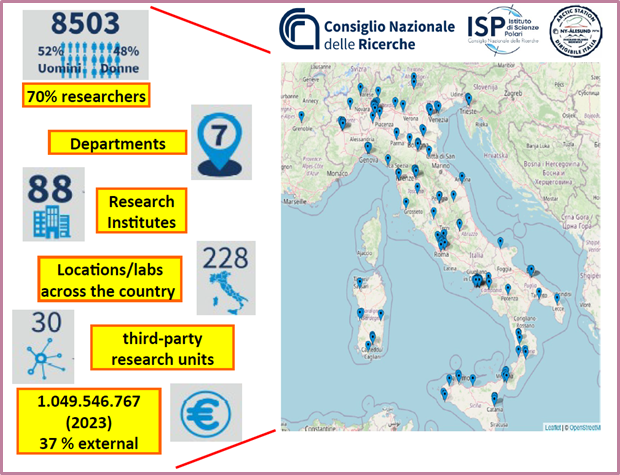Vito Vitale and Maurizio Azzaro (CNR)
The National Research Council (CNR) is the largest public research institution in Italy, the only one under the Research Ministry performing multidisciplinary activities.
Founded as legal person on 18 November 1923, CNR’s mission is to perform research in its own Institutes, to promote innovation and competitiveness of the national industrial system, to promote the internationalisation of the national research system, to provide technologies and solutions to emerging public and private needs, to advise Government and other public bodies, and to contribute to training the next generation of professionals.

As reported above, CNR is organised in in 7 Departments coordinating the activities of more than 100 Institutes/Research Units in the main fields of knowledge, from life sciences to engineering, from earth system science to humanities, and managing the research infrastructures.
In the CNR's research world, the main resource is the available knowledge which means people, with their skills, commitment and ideas. This capital comprises more than 8.000 employees, of whom more than half are researchers and technologists. Some 4000 young researchers are engaged in postgraduate studies and research training at CNR within the organisation’s top-priority areas of interest. A significant contribution also comes from research associates: researchers, from Universities or private firms, who take part in CNR’s research activities.
The CNR Department of Earth System Science and Environmental Technologies (CNR-DSSTTA) mission is to support and coordinate the research activities carried out by its 12 associated Institutes dealing with environmental sciences, including climate change, and the development of innovative monitoring technologies. The activities of the Department of Earth System Science and Environmental Technologies (DSSTTA) are carried out by a staff of approximately 1100 people supported by approximately other 800 collaborators in the research area.
The Institute of Polar Sciences (CNR-ISP) has been recently founded as part of the CNR to harmonise remarkable capabilities of the CNR in the field of polar research and management of large research infrastructures. It provides a platform able to catalyse and promote multi-disciplinary research, to advance the understanding of the processes of the Polar Regions and their interactions with the humankind, as well as CNR involvement in international initiatives. The activities of the ISP-CNR are carried out by a staff of approximately 75 people, supported by approximately 30 collaborators from different research areas. ISP-CNR conducts and coordinates Polar research in the framework of the Italian Arctic (PRA) and Antarctic (PNRA) Programme, mainly focused on multidisciplinary environmental research. It pursues this goal through:
- Conducting research in both Polar Regions (Antarctica, Greenland and Svalbard) mainly in the area of atmospheric and marine sciences, paleoclimate research and biogeochemical cycle of elements.
- Performing laboratory and field based applied research and education, focusing on monitoring and management of the environment;
- Developing approaches to support problem-solving in Polar sciences and decision-making for sustainable development;
- Communicating its results to promote understanding and awareness, to the benefit of the wider society.
The experimental and modelling aspects are combined with technological interests as well as EO activities. CNR-ISP is involved in activities of SIOS and EU projects as ARICE, EU-POLARNET, INTERACT, ARCTIC-PASSION, POLARIN among all.
The infrastructure of CNR in the Arctic
CNR-DSSTTA maintains and manages, thanks to ISP, one scientific station in the Arctic region. The Italian Arctic Station Dirigibile Italia is a multidisciplinary research facility located in Ny-Ålesund on the Norwegian Archipelago of Spitsbergen (Svalbard). The station was opened in 1997 and supports interdisciplinary research in the following fields: atmospheric chemistry and physics, upper atmosphere physics, technology, oceanography, environmental studies, human biology and medicine. At the station are implemented three important multidisciplinary observation platforms: the Amundsen-Nobile Climate Change Tower (CCT), the aerosol and Gruvebadet interface processes lab (GVB), a Marine Observatory in Kongsfjorden Krossfjorden System (Three moorings and a oceanographic buoy), a mooring in south-West offshore Svalbard (Mooring S1 in collaboration with INOGS). A network of temperature and brightness sensors has also recently been implemented in the ponds of the Ny-Ålesund area on the Spitsbergen Arctic Archipelago (Svalbard Island). ISP-CNR has an internationally recognised laboratory to perform analyses of inorganic chemical species at trace and ultra-trace levels in environmental samples (snow, ice, wet and dry deposition, soils, water samples) using cutting-edge techniques and two new clean rooms (class 100) for the pre-analytical operations and preparation of samples for organic and inorganic compound analyses. CNR-DSSTTA Institutes can take advantage of the Italian infrastructures in Antarctica operated in the frame of PNRA as well as of the new Italian icebreaker Laura Bassi recently acquired for the national science polar community.



























